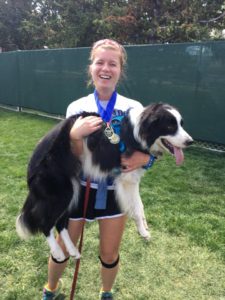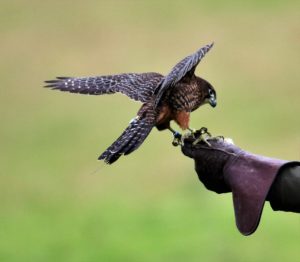I. Love. Goal. Setting.
I don’t just mean New Year’s Resolutions, though I’m an avid keeper of those as well. Let’s look at my system for micro- to macro-goals as well as the strategies I use to stick to them. We’ll even take a sneak peak at my Annual goals for 2018!
Daily Goals:
Every morning, my boyfriend Andrew and I text each other with our goals for the day. We limit ourselves to three top-line goals. I try to have one fitness goal, one personal goal, and one work goal per day. At night right before bed, we touch base on our initial goals for the day. Many days we don’t achieve them, and other days we’re too tired to talk about them. But building this habit is a goal of its own!

For example, today my three goals are:
- Fitness: complete my lifting workout despite being in Seattle visiting Andrew’s family for early Christmas.
- Personal: start working on the basic website for El Perro Tambien.
- Work: finish my freelance article for K9 of Mine.
The accountability of this system has done wonders for me!
Weekly Goals:
At the start of each three-day weekend, I write down a few goals that I hope to achieve before I head back to my 10-hour shifts at the shelter. Finishing this website a few weeks ago was my topline goal for that weekend. I don’t necessarily share these weekly goals with Andrew, though smaller components of them may make it into my daily goals. I write these down on a master post-it note on Tuesday night, and keep referencing it through Wednesday, Thursday, and Friday.
For example, my weekly goals are:
- Finish my K9 of Mine article on time (related to today’s goal).
- Stick to my training plan while on vacation (related to today’s goal).
- Finish the homepage for a freelance web design project (done yesterday).
This week’s goals are relatively light to account for being on vacation. I have some nebulous goals along the lines of learning more about Andrew’s family and catching up on sleep, but they’re to ephemeral to make it onto the master post-it note for the week.
Monthly Goals:
This is an area that needs improvement in 2018. I had no formal way of keeping track of monthly goals for 2017, and really didn’t set them. Instead, I focused on very short-term goals and big-picture goals. This strategy worked well for me, since my months still followed a big arc of short-term goals that worked on big-picture goals. However, I didn’t have any deadlines that I set for myself on a monthly basis.
Instead, I broke my 2017 goals into a few monthly chunks. I consider these annual goals rather than monthly, since they culminate over the year. For example, a 2017 goal was to go to Bar Trivia or one other fun social thing once per month. I phrased this as an annual goal, since it’s month-over-month, not month-by-month. If my July goal was to go to the Harry Potter Trivia at Colorado Brewing Company, that would have been a monthly goal.
Semantics.
The point is, in 2018, I plan to set monthly goals with a deadline at the end of the month. Perhaps “Setting a Monthly Goal” will be one of my annual goals for 2018!
Annual:
I track my annual goals using Stickies from Apple. These fit nicely onto my laptop screen, where I’m constantly reminded of them. The same goes for my five year and ten year goals. Next year, my monthly goal will share this space.
My annual goals are broken down into four categories:
 Work: Make $300/month in average income from dog training (tripled this goal). Get 10 new dog training clients with at least three sessions per client (complete).
Work: Make $300/month in average income from dog training (tripled this goal). Get 10 new dog training clients with at least three sessions per client (complete).
Health: lead 15 trad climbing pitches. I didn’t even start this goal, I’m ashamed to say. However, I did run my first marathon. I have plenty of excuses for why this goal never materialized, but they hardly matter. I think this goal will roll over to 2018, and I’ll utilize the strategies outlined below to ensure its completion.
Personal: Go to bar trivia or one other fun social thing per month. I stuck to this one very well! I decided on this goal after realizing how much I derive happiness from the presence of others. To combat some dark moods and loneliness following college graduation, I decided to make social fun an explicit goal. It worked, and I’m happy to say that I’m in a much sunnier place mentally than I was this time last year.
Pets: Adopt a dog. I adopted Barley on March 10, 2017 – and my life hasn’t been the same since. If I’m being realistic, he’s probably part of the reason that trad leading got superseded by marathon training. Barley is a much better running buddy than climbing partner, and I love spending my weekends with him!
Five Year:
Again, I keep my five year goals on a pink Sticky on my laptop’s desktop. These are to be completed by 2021. As I complete these five-year goals, I’ll replace them with new goals with new five-year due dates.
Work: Create a puppy culture program at Dumb Friends League (on track to be implemented by January 1). Next up: find a remote-friendly job that I’m passionate about that also pays the bills.
Health: Complete an Ironman. I think I’ll sign up for a race in 2018 or 2019 and just commit to training for it!
Personal: earn a Fulbright scholarship to study kea cognition in New Zealand.
Ten Year:
These aren’t broken down into strict categories like my annual and five year goals. Many of them are too broad to bother! These goals are “due” in 2026.They are as follows:
Obtain my PhD. This is a follow-up to my planned Fulbright year in New Zealand. It’s just a matter of winning a Fulbright!
 Earn my falconer’s license. I trained my first falcon in 2014, a little Kestrel that lived at the Northern Great Lakes Visitor Center. Ever since, I’ve always wanted to have my license do this on my weekends. If all goes well, I will be stable enough and have enough money and free time to pursue this goal in the future.
Earn my falconer’s license. I trained my first falcon in 2014, a little Kestrel that lived at the Northern Great Lakes Visitor Center. Ever since, I’ve always wanted to have my license do this on my weekends. If all goes well, I will be stable enough and have enough money and free time to pursue this goal in the future.
Have a nudibranch aquarium. While studying abroad in Ecuador, I fell totally in love with nudibranchs. They’re difficult little saltwater creatures to grow, so this goal represents having a lot of stability and time to learn to cultivate a high-end saltwater aquarium.
Strategies to Pursue and Keep my Goals
I’m a dog trainer and I love the science of habit and behavior change. That’s why my two favorite books of 2017 were The Power of Habit and Thinking, Fast and Slow. I use many of the skills that I’ve learned from training dogs (and teaching clients how to train dogs) to stay on track with my goals.
The three big ones are:
Splitting: if my goal is to climb Half Dome by 2021, I’ve got to complete a lot of smaller goals first. Climbing Half Dome by 2021 isn’t going to be possible if I don’t get my act together to start leading more trad climbs in 2018. If my goal is leading 15 trad pitches in 2018, my monthly goal could be to lead 2 pitches per month and climb outside twice per month. On a weekly basis, I could have the goal of climbing indoors twice per week or reading a crack climbing book for 20 minutes before bed. Day by day, my goals could be as specific as climbing a specific route, doing 3 pull-ups each time I pass through the doorway that holds my pull-up bar, or sleeping 8 hours to prepare for the next day’s climb.
Basically, big goals need smaller goals as building blocks. If you’re struggling with a goal, there’s a good chance that you’ll have better luck if you “split” that goal into several smaller ones first.
Premack Principle: this is one of my favorites! In dog training, Premack is used to reward a dog for a desired behavior (sitting) with an environmental reward that they really want (chasing the squirrel). Generally, you reward a less-likely behavior with a more-likely behavior.
I’ve taken this goal and used it for myself in goal-setting. I really love going running with Barley, and often will brush off freelance work in order to go running. Once I realized that I had a habit of putting off one important goal at the expense of another, I started implementing the Premack Principle. This means I can only go running if I finish my article first. My motivation to finish my article is the reward of going for a run!
On days where I’m less motivated, I might not let myself go out for lunch unless I write enough words to pay for that meal. All I’m doing is setting up rules where I reward myself for completing a task. The magical thing about Premack is that I’m using a functional reward that’s also usually good for me. I could reward myself with 1 Hershey’s kiss per page written, and that likely would increase my motivation. But I’ve found that that makes my teeth and stomach hurt, and isn’t sustainable in the long run because it doesn’t make me feel good. Running feels good, so it’s a better motivator for me.
SMART Goals: yeah, yeah. We all kind of know about SMART Goals, right? I don’t need to beat a dead horse, but a SMART goal is: Specific, Measurable, Achievable, Relevant, and Time-Bound. Let’s look at an example:
“Complete an Ironman by 2021.”
Specific: yes. There’s a specific race series out there, and I have to complete one of these sanctioned races.
Measurable: yes. I can measure that I’ve crossed the finish line of said race. I also can measure little check-marks along the way. For example, in 2017 I ran a full marathon – my first. I won’t be able to do an Ironman if I can’t also swim 2.4 miles, bike 112, and run 26.2. So my shorter-term goals that help me achieve this goal are also measurable and specific.
Achievable: yes. Lots of people do Ironmans every year. They’re mega-tough, but it should be possible for me to train and prepare for one. Barring injury or illness, there’s no real reason that I can’t do an Ironman. I just have to put in the time and energy to train.
Relevant: on a personal level, but not professional. Completing an Ironman has always been a personal dream for me. It represents time, grit, commitment, and stamina that I admire. It’s a relevant personal goal for me, though it doesn’t have much to bear for my professional life.
Time-Bound: yes. Because my goals all have built-in due dates, they’re all Time-Bound.
So there ya have it, most of my goals fit into the SMART framework.
2018 New Year’s Resolutions (Annual Goals)
 It’s December 15, and I’m starting to really think about my Annual Goals for next year. Notice how they’re SMART goals. Some are “split” from my five- or ten-year goals, and they all will likely be “split” into monthly, weekly, and even daily goals at times.
It’s December 15, and I’m starting to really think about my Annual Goals for next year. Notice how they’re SMART goals. Some are “split” from my five- or ten-year goals, and they all will likely be “split” into monthly, weekly, and even daily goals at times.
- Work: Apply for a Fulbright scholarship. I’m currently in the process of cultivating a Fulbright Scholarship to study Kea cognition with Dr. Alex Taylor of University of Auckland. It’s due in October 2018.
- Health: Lead 15 trad pitches (rollover from 2017). One of the big to-dos for me is to create a bigger plan for how to achieve this goal in 2018, since I did such a poor job of it in 2017. I haven’t yet come up with an excellent “splitting” plan to ensure that I complete this goal.
- Run 1 marathon. I plan to sign up for a marathon somewhere in Central or South America. Once I sign up, I have full confidence that I’ll train and complete it. This will help keep me on track for my Ironman 2021 goal!
- Train to swim 2.4 miles in open water. I won’t own a bike next year, so the next big component of my Ironman 2021 goal is to prepare for the swim. Like leading 15 trad pitches, this goal will require planning and splitting.
- Personal: Take 1+ continuing education class per month. To keep myself accountable, I’ve already signed up for many courses that I’m excited about taking. I can’t wait to get started! Udemy had a huge sale, so I signed up for courses on:
- Podcasting
- SEO
- X Theme
- Digital Marketing
- Google Analytics
- Cognitive Behavioral Therapy
- Life Coaching
- Yoga
- Facebook Ads
- Monetizing a blog
- Advanced copywriting
- Basic coding
- Pets: Train Barley to do an off-leash contact heel for 2 city blocks on a normal residential street. This is 100% a vanity goal. I love training dogs and am excited for the challenge of teaching Barley some really difficult but unnecessary tricks. He’s already got the basics down pat, so let’s keep upping the ante!
What are your goals for 2018? How do you stay on track?
